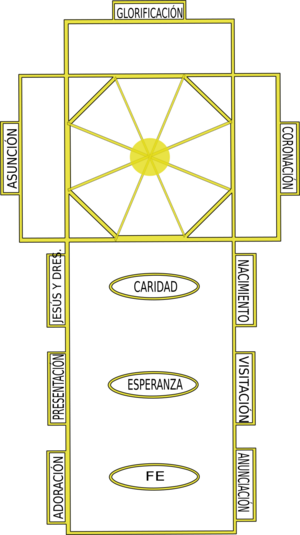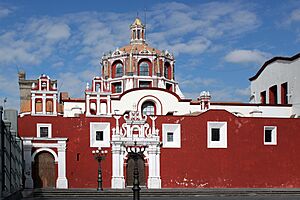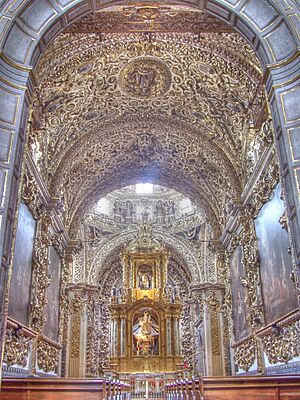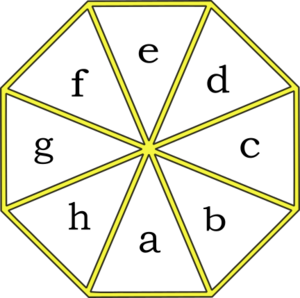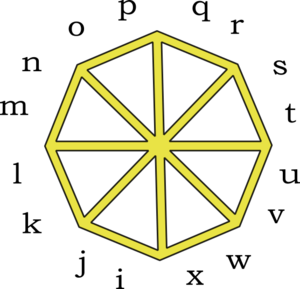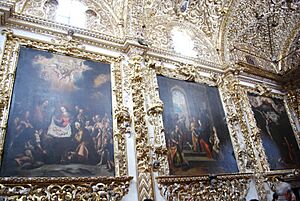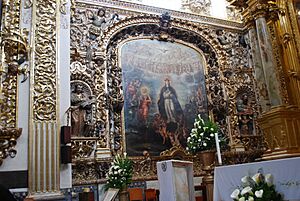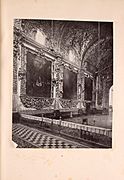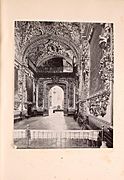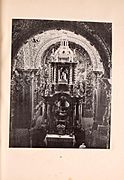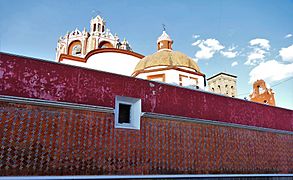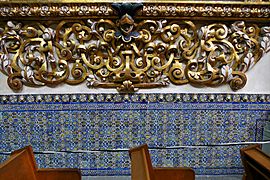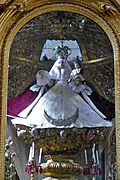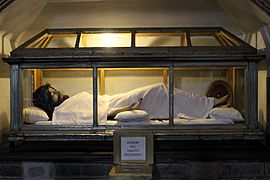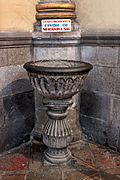Chapel del Rosario, Puebla facts for kids
The Chapel of the Virgen del Rosario is a beautiful chapel in the city of Puebla, Mexico. It's connected to the Church of Santo Domingo. Built in the 1600s, it's a top example of the amazing New Spanish Baroque style. People at the time called it the "Eighth Wonder of the World" and "The Golden House" because it's so incredibly decorated with gold.
This chapel is full of symbols that explain beliefs of the Catholic Church and the Dominican Order. It's located on 5 de Mayo street, number 407. The chapel is also part of the Historic Center of Puebla City, which was named a UNESCO World Heritage site in 1987.
Contents
History of the Chapel
The Dominican Order really loved the Virgin of the Rosary. They built special chapels for her in all their churches. In Mexico, the Dominicans arrived in 1526. They started building their main church in Puebla in 1531.
The Chapel of the Rosary was planned much later, around 1650. It was finished and officially opened on April 16, 1690. This chapel was the first in Mexico built just for the Virgin of the Rosary. It had two main goals: to honor the Virgin and to teach people how to pray the Holy Rosary.
Friar Juan de Cuenca started building it in 1650. But it was such a huge project that it took a long time. Two other Dominicans, Friar Agustín Hernández and Friar Diego de Gorozpe, finished it. They opened it on the same day the City of Puebla was founded. The opening celebration lasted for eight days, with sermons, parades, and lots of joy!
Because of its beauty and importance, the chapel was quickly called the "Eighth Wonder of the World." In 1971, a team of experts worked to restore the chapel, making sure its beauty would last.
Chapel's Amazing Architecture
The Chapel of the Rosary shows how rich and powerful the Church was back then. It also shows how grand and detailed churches were designed.
The chapel is shaped like a Latin cross, which is common for churches. The main part, called the nave, has three sections. Its ceiling, or vault, is curved like a barrel. There's also a beautiful dome with windows that let light shine down on the main altar.
The inside of the chapel is truly amazing. Every single part of the walls and ceilings is covered in golden stucco reliefs. This incredible decoration was meant to make people feel closer to their faith.
On the side walls, you'll see large paintings by an artist named José Rodríguez Carnero. These paintings show happy moments from the life of the Virgin Mary. They use a style called Chiaroscuro, which means they have strong contrasts between light and dark.
Below the paintings, the walls are covered with beautiful azulejos, which are special ceramic tiles from Talavera pottery.
More paintings about the Virgin's life are in the crossing area. A huge painting at the very end of the chapel shows the Virgin of the Rosary being honored. The golden reliefs all over the chapel show plants, animals, angels, and religious symbols.
The chapel is decorated with a special kind of gold leaf called "overgilded plasterwork." It was made from a mix of flour, egg white, and water, then covered with pure 24-carat gold leaves.
The main altar has a special throne for the Virgin. It's covered by a beautiful canopy, or baldachin, carved by a Spanish artist named Lucas Pinto.
Entrance Portal
The entrance to the chapel is on the left side of the main church. Its design is simpler than the inside, but still beautiful. It has rounded arches and columns with detailed carvings.
Inside the Chapel
The chapel's design, shaped like a Latin cross, is a dazzling example of the 17th-century New Spanish Baroque style. Every part of it has a special meaning. On the ceiling, you can see figures representing three important virtues: Faith, Hope, and Charity. There are also sixty angels all around the dome and main ceiling. Each angel looks different, some are just heads, others are full bodies. In the area where the choir and organ are, you'll find angels playing musical instruments and singing.
The Dome
The dome is a very important part of the chapel.
- Divine Grace is shown holding a palm leaf, which means martyrdom, and a laurel branch for victory. Grace is seen as the start of all good things on Earth.
- It is joined by the Seven gifts of the Holy Spirit:
- Understanding
- Fortitude (bravery)
- Piety (devotion)
- Fear of God (respect for God)
- Knowledge
- Counsel (good advice)
- Wisdom
These qualities are shown as female figures. The symbols teach that with faith, hope, charity, and these gifts, you can reach true wisdom. This wisdom is shown by a dove, representing the Holy Spirit, surrounded by clouds and rays in the dome.
The dome also features 16 female saints: Saint Ursula, Saint Agatha, Saint Agnes, Saint Anastasia, Saint Apollonia, Saint Clare, Saint Gertrude, Saint Lutgardis, Saint Rosalia, Saint Rose of Viterbo, Saint Teresa of Ávila, Saint Thecla, Saint Barbara, Saint Cecilia, Saint Lucy, and Saint Catherine of Alexandria.
Amazing Paintings

On the sides of the main hall, there are six large paintings by José Rodríguez Carnero. They show happy moments from the Virgin Mary's life, like the Assumption, the Visitation, and the Birth of Jesus. On the other side, you'll see the Adoration of the Magi, the Presentation in the Temple, and Jesus among the doctors. These paintings show important times in Mary's life on Earth.
The lower parts of the walls are covered with beautiful Talavera pottery tiles. On top of these tiles, you can see smiling faces of cherubim mixed with the Dominican coat of arms.
The Crossing Area
Even though this part of the chapel is short, it has the same rich decoration as the main hall. On the left, there's a painting of the Assumption of Mary. Next to it are carved figures of John the Apostle and Matthew the Apostle. Above them, surrounded by flowers, are Elizabeth and Saint Joseph.
On the right side, you'll find a painting of the Coronation of Mary. There are also figures of Mark the Evangelist and Luke the Evangelist. Near the window, you can see Joachim and Saint Anne. These four evangelists are honored because they were the first to write about the Virgin Mary. Her family is shown here with angels, flowers, birds, and pelicans, which symbolize Christ.
The Apse
At the very end of the chapel, in the apse, there's a huge painting. It shows the "Glorification and Triumph of the Rosary." In this painting, the Virgin is crowned with roses. This painting, along with those in the crossing, tells the story of Mary's life in heaven. It shows her going to heaven, being crowned, and then coming back to Earth to share the Rosary.
The Altar
The altar area reminds us how religious buildings and their symbols are connected. The square shape of the crossing represents the earth. The eight-sided base of the dome shows new life after death. And the perfect curve of the dome represents heaven, or paradise.
The Ciprés
The ciprés is a tall, decorative structure under the dome. It protects the statue of the Virgin of the Rosary. It has twelve Corinthian columns at its base, made of marble from Tecali de Herrera. These columns represent the apostles.
On the first level, you can see statues of Dominican saints. On the second level, there are twelve beautiful solomonic columns. These columns are twisted and covered with roses and lilies. They frame a statue of Saint Dominic. Saints in the ceiling niches hold flowers. Four decorative ribs are covered with plants, like a vine. There are also detailed carvings of local plants, showing the richness of the land. A small carving even represents the sun. At the very top, on the roof lantern, is the Archangel Gabriel. This figure completes this amazing Baroque artwork, created by Lucas Pinto.
The Choir Area
In the choir area, you can see a relief carving. It shows a group of children playing musical instruments, joined by angels, all led by God the Father.
More Images
-
Talavera azulejos on the wall.
See also
 In Spanish: Capilla del Rosario (Puebla) para niños
In Spanish: Capilla del Rosario (Puebla) para niños
- Church of Santo Domingo, Puebla
- Our Lady of the Rosary
- List of buildings in Puebla City


